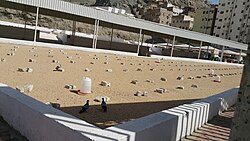Jannat al-Mu'alla
This article needs additional citations for verification. (October 2012) |
| Jannat al-Mu'allah | |
|---|---|
 Jannat al-Mu'alla cemetery | |
 | |
| Details | |
| Location | Makkah, Hijaz |
| Country | Saudi Arabia |
| Coordinates | 21°26′13″N 39°49′45″E / 21.43694°N 39.82917°E |
| Type | Islamic |
| Owned by | Islam |
| No. of graves | Relatives of Muhammad |
Jannat al-Mu'alla (Arabic: جَنَّة ٱلْمُعَلَّاة, romanized: Jannah al-Muʿallāh, lit. 'The Most Exalted Paradise'), also known as the "Cemetery of Ma'la"[1] (Arabic: مَقْبَرَة ٱلْمَعْلَاة Maqbarah al-Maʿlāh) and Al-Ḥajūn (Arabic: ٱلْحَجُوْن), is a cemetery to the north of Al-Masjid Al-Haram, and near the Mosque of the Jinn in Makkah, Saudi Arabia. It is the place where the Islamic prophet Muhammad's wife, grandfather, and other ancestors are buried.
History
[edit]
Many of Muhammad's relatives were buried in this cemetery before his Hijrah in 622.[citation needed] Many domes and structures have been built or rebuilt over known graves over the years.[2] Tombs in this cemetery were demolished in 1925, the same year that the Jannat al-Baqi' cemetery in Medina was demolished by the Saudi King, Ibn Saud. According to Wahabi tradition of Sunni Islam, shrines are forbidden to be built over a grave so as to not take any saint or dead person for worship. This happened despite protests by the international Shia community.[3] Some Shiites continue to mourn the day the House of Saud demolished shrines in Al-Baqi, which has been named Yaum-e Gham or "Day of Sorrow", and protest the Saudi government's demolition of these shrines.
Notable interments
[edit]
Historical figures buried here include:
| Name | Notes | |||||
|---|---|---|---|---|---|---|
| Companions of Muhammad | ||||||
| Abu Talib ibn Abd al-Muttalib | Uncle of Muhammad; father of Ali and Chief of Banu Hashim | |||||
| Abd Manaf | Great-great-grandfather of Muhammad and Ali | |||||
| Abd al-Muttalib | Grandfather of Muhammad and Ali | |||||
| Khadijah | The wife of Muhammad and mother of Zainab, Fatimah, Ruqayya and Umm Kulthum of Banu Asad (tribe) | |||||
| Qasim ibn Muhammad | the first son of Muhammad and Khadijah | |||||
| Asma bint Abu Bakr | A companion of Muhammad and mother of Abd Allah ibn al-Zubayr | |||||
| Abdullah ibn Zubair | A companion of Muhammad and a nephew of Aisha | |||||
| Notable Buriels of Scholars | ||||||
| al-Mansur | Second Abbasid Caliph and the founder of Baghdad | |||||
| Rahmatullah Kairanwi | 19th-century Indian Sunni Muslim scholar and author of Izhar ul-Haqq[4] | |||||
| Imdadullah Muhajir Makki | Another 19th-century Indian Muslim scholar[5] | |||||
| Abu Turab al-Zahiri | 20th-century Muslim cleric | |||||
| Muhammad Alawi al-Maliki | 20th-century Sunni Muslim cleric | |||||
| Mulla Ali Qari Herawi | Sunni scholar of Tafseer Quran, Fiqh, Theology, Arabic Language | |||||
| Ahmad Mashhur al-Haddad | Sunni scholar of Islam prominent in Yemen, Africa, and Saudi Arabia | |||||
| Sheikh Ismail Mahamud Cigaal | Sunni Scholar of Islam prominent in Somalia and East Africa | |||||
See also
[edit]References
[edit]- ^ Tütüncü, Mehmet (2015). "The Uppsala Makkah Painting: A New Source for the Cultural Topography and Historiography for Mecca". In Buitelaar, Marjo; Mols, Luitgard (eds.). Hajj: Global Interactions through Pilgrimage. Leiden: Sidestone Press. pp. 137–163. ISBN 978-90-8890-285-7.
- ^ "History of JANNAT AL-MAULLA". Archived from the original on 11 September 2019. Retrieved 26 August 2015.
- ^ "History of the cemetery of Jannat al-Baqi". 23 December 2013. Retrieved 26 August 2015.
- ^ Mawlāna Abd al-Rashīd Arshad. "Mujāhid-e-Islām Mawlāna Rahmatullah Kairānwi Muhājir Makki". In Deobandi, Nawaz (ed.). Sawaneh Ulama-e-Deoband (in Urdu). Vol. 1 (January 2000 ed.). Deoband: Nawaz Publications. p. 444.
Adapted from Āsār-e-Rahmat of Imdād Sābri
- ^ Mawlāna Abd al-Rashīd Arshad. "Hadhrat Hāji Imdādullah Muhājir Makki". In Deobandi, Nawaz (ed.). Sawaneh Ulama-e-Deoband (in Urdu). Vol. 1 (January 2000 ed.). Deoband: Nawaz Publications. p. 367.
